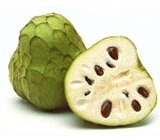Languages
Cherimoya

The cherimoya fruit is heart-shaped, with a slightly sunken skin with black inedible seeds. The taste of the cherimoya is sour-sweet to sweet; the white-yellowish flesh is melting, but not very juicy. Cherimoyas are available nearly the whole year round. The fruit is oval, often slightly oblique, 10-20 cm long and 7-10 cm diameter, with a smooth or slightly tuberculated skin. The fruit flesh is white, and has numerous seeds embedded in it. Mark Twain called the cherimoya "deliciousness itself."
The cherimoya grows best in tropical altitudes or in frost-free tropical areas. It is cultivated in many places throughout the Americas, including California and Hawaii. In the Mediterranean region, it is cultivated mainly in southern Spain, Madeira and Israel. It is also grown in Taiwan.
